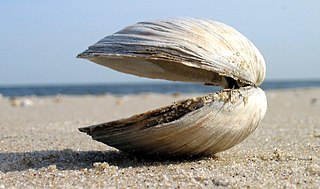
Clam is a common name for several kinds of bivalve molluscs. The word is often applied only to those that are edible and live as infauna, spending most of their lives halfway buried in the sand of the seafloor or riverbeds. Clams have two shells of equal size connected by two adductor muscles and have a powerful burrowing foot. They live in both freshwater and marine environments; in salt water they prefer to burrow down into the mud and the turbidity of the water required varies with species and location; the greatest diversity of these is in North America.
Nuculana acuta, or the pointed nut clam, is a marine bivalve mollusc in the family Nuculanidae. It can be found along the Atlantic coast of North America, ranging from Massachusetts to Texas, including the West Indies.

Arca imbricata, or the Mossy ark clam, is a clam in the family Arcidae. It can be found along the Atlantic coast of North America, ranging from North Carolina to the West Indies, Brazil, and Bermuda.
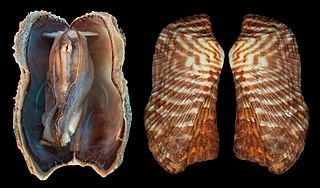
Arca zebra, or the turkey wing ark clam, is a bivalve mollusc in the family Arcidae, the ark clams.

Barbatia cancellaria, or the Red-brown ark clam, is a clam in the family Arcidae. It can be found along the Atlantic coast of North America, ranging from Florida to the West Indies.

Barbatia candida, or the White-bearded ark clam, is a clam in the family Arcidae. It can be found along the Atlantic coast of North America, ranging from North Carolina to Texas, including the West Indies.

Barbatia domingensis, or the White miniature ark clam, was for many years a name that was commonly used for a marine clam in the family Arcidae.

Barbatia tenera, or Doc Bales' ark clam, is a clam in the family Arcidae. It can be found along the Atlantic coast of North America, ranging from southern Florida to the West Indies.

Anadara brasiliana, common name the incongruous ark clam, is a saltwater clam in the family Arcidae, the ark shells. This species is found along the Atlantic coast of North America, from North Carolina to Brazil.
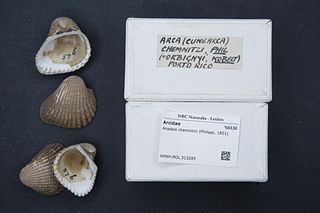
Anadara chemnitzii, common name Chemnitz's ark clam, is a saltwater clam in the family Arcidae, the ark shells. This species is found in the Caribbean Sea, from Texas to the West Indies and Brazil.
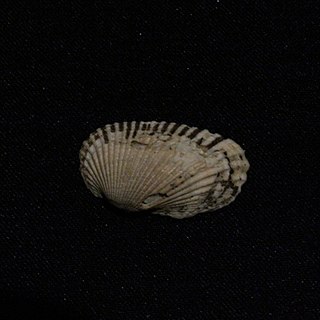
Anadara secticostata, also known as the cut-ribbed ark clam, is a white colored saltwater clam in the family Arcidae. It can be found along North American coast of the Atlantic Ocean, ranging from North Carolina to Texas, including the West Indies. Its shell grows up to 100mm, and the periostracum is dark brown. Its shape is slightly inequivalve, oblong and large. It consists of 30–38 curved radial ribs which increase in width towards the edges. These ribs are faintly incised, the groove is longitudinal.

Anadara notabilis, or the Eared ark clam, is a clam in the family Arcidae. It can be found in Caribbean waters, ranging from Florida to Bermuda and Brazil.

Anadara transversa, or the Transverse ark clam, is a clam in the family Arcidae. It can be found along the Atlantic coast of North America, ranging from Massachusetts to Texas, including the West Indies.
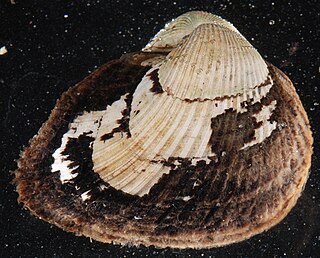
Noetia ponderosa, or the ponderous ark clam, is a marine clam in the family Noetiidae.

Kalolophus speciosus, or Gibbs' clam, is a species of bivalve mollusc in the family Crassatellidae. It can be found along the Atlantic coast of North America, ranging from North Carolina to the West Indies.
Americardia media, the Atlantic strawberry cockle, is a species of saltwater clam, a marine bivalve mollusc in the family Cardiidae, the cockles. This species can be found along the Atlantic coast of North America, from Cape Hatteras to the West Indies.
Lamelliconcha circinata, common name the "purple venus clam", is a species of bivalve mollusc in the family Veneridae, the venus clams. This species can be found around the coasts of the islands in the West Indies.
Pitarenus cordatus, or the cordate venus clam, is a species of bivalve mollusc in the family Veneridae. It can be found throughout the Gulf of Mexico and the Florida Keys.

Macrocallista maculata, or the calico clam, is a species of bivalve mollusc in the family Veneridae. It can be found along the Atlantic coast of North America, ranging from North Carolina to Bermuda and Brazil.
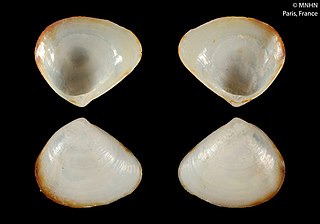
Parvicirce is a genus of saltwater clams, marine bivalve molluscs in the family Veneridae, the venus clams.
















